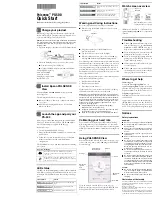
24
Rack Mounting
The VT201 monitors are designed to be mounted without slides in an EIA 19” rack cabinet. The
hole pattern on the monitor’s front panel allows mounting the unit on rack rails that have either a
“Wide” or a “Universal” hole pattern.
Before installing the monitor in a rack, ensure that the following conditions for installation are met:
•
Adequate ventilation must be available within the rack cabinet to ensure that monitor is not
exposed to ambient temperatures above 50°C.
•
The relative humidity of the air within and around the rack cabinet should not exceed 85%.
•
Following installation, there must be sufficient clearance around the ventilation holes in the
monitor’s rear enclosure to allow good circulation. Whenever possible, avoid mounting the monitor
in the uppermost part of the rack cabinet.
•
Power and earth ground should be accessible when the monitor is installed in the cabinet
Installation in the rack cabinet is easy and should proceed as follows:
•
Before positioning the monitor on the rack rails, identify the holes in the rails that will match up to
the holes in the monitor’s panel and install clip nuts in those holes. Please refer to the appropriate
outline drawing for the locations of the holes in the monitor panel.
•
If there is no access to the monitor from the rear of the cabinet following installation, power,
ground and video connections should be made prior to installing the monitor on the rails. Please
refer to the following sections of the manual for connection guidelines.
•
Position the monitor on the rails and run screws through the front panel holes into the
pre-installed clip nuts.
NOTE:
About “Universal” vs. “Wide” hole spacings on EIA rack cabinet rails.
The mounting rails that run vertically along the inside edges of the front and rear openings of
EIA rack cabinets can be of two types. “Wide” rails have holes spaced 0.5” and 1.25” on
centers, in a repeating pattern. These rails are prevalent in Europe. “Universal” rails have
holes spaced 0.5” 0.625” and 0.625” on centers, in a repeating pattern. Thus the “Universal”
rails have a hole pattern that contains the “Wide” pattern but provides an additional hole at the
midpoint of the pattern. “Universal” rails are most prevalent in the U.S.
NOTE:
To provide maximum comfort for the user, the monitor should be mounted so that the top of the
screen is at or slightly below eye level, and so that light from nearby windows, overhead
fixtures, etc. does not reflect off the screen.
NOTE:
The monitor must be positioned on the rack rails in such a way that the top and bottom edges
of its panel fall midway between rail holes spaced 0.5”.
7.3
VESA Arm or Yoke Mounting
The VT201 monitors are designed for mounting to an articulated arm that provides a mounting
flange with a VESA standard hole pattern. Please refer to mounting instructions supplied with the
VESA arm to be used.
7.2
Summary of Contents for VT201CM
Page 27: ...20 1 PowerVue User Guide 150 055 25 ...
Page 28: ...26 ...





































